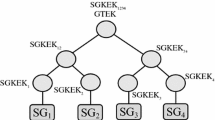Abstract
Wireless authentication and key establishment (WAKE) protocols are essential in mobile communications. The key recovery mechanism may also be required in mobile communication systems for the investigation of serious crimes and for national security. Recently some protocols that give key recovery in the WAKE protocol have been published. In this paper we propose new key recovery protocols that improve previous protocols in security and efficiency.
Chapter PDF
Similar content being viewed by others
Keywords
- Secret Sharing
- Universal Mobile Telecommunication System
- Universal Mobile Telecommunication System
- Mobile Communication System
- Modular Exponentiation
These keywords were added by machine and not by the authors. This process is experimental and the keywords may be updated as the learning algorithm improves.
References
U. Black, “Third Generation Mobile Systems (TGMSs)”, Second Generation Mobile & Wireless Networks, Prentice Hall, 1999
T. Ojanpera and R. Prasad, “IMT-2000 Applications”, Wideband CDMA for Third Generation Mobile Communication, T. Ojanpera and R. Prasad (ed.), Artech House Publishers, pp.65–76,, 1998
K. Buhanal et al., “IMT-2000: Service Providers Perspective”, IEEE Personal Communications, August 1997
ETSI SMG10, “Universal Mobile Telecommunications System (UMTS): Security Requirement”, Draft UMTS 33.21 version 2.0.0, Feb., 1999
NIST, “Escrow Encryption Standard (EES)”, Federal Information Processing Standard Publication (FIPS PUB) 185, 1994
J. Nieto, D. Park, C. Boyd, and E. Dawson, “Key Recovery in Third Generation Wireless Communication Systems”, Public Key Cryptography-PKC2000, LNCS 1751, pp.223–237, 2000
K. Rantos and C. Mitchell, “Key Recovery in ASPeCT Authentication and Initialization of Payment protocol”, Proceedings of ACTS Mobile Summit, Sorrento, Italy, June 1999
ETSI TC Security, “Specification for Trusted Third Party Services: Part1 Key Management and Key Escrow/Recovery”, DEN/SEC-003001x, Draft Version 1.0 (edition2), 11th Nov, 1997
ETSI TC-STAG, “Security Techniques Advisory Group (STAG); Definition of User Requirements for Lawful Interception of telecommunications: Requirements of the Law Enforcement Agencies”, ETR 331, December 1996.
B. Pfitzmann and M. Waidner, “How to BreakF raud-Detectable Key Recovery”, Operating Systems Review, 21, 1998, pp.23–28
G. Horn and B. Preneel, “Authentication and payment in future mobile systems”, Computer Security-ESORICS’98, LNCS, 1485, pp.277–293, 1998
ACTS AC095, ASPeCT Deliverable D02, “Initial Report on Security Requirements”, AC095/ATEA/W21/DS/P/02/B, Feb., 1997, Available from http://www.esat.kuleuven.ac.be/cosic/aspect/
T. Pederson, “Distributed provers with application to undeniable signatures”, Advances in Cryptology-Eurocrypt’91, LNCS vol. 963, pp.222–242, 1991
A. Menezes, P. Oorshot, and S. Vanstone, Handbook of Applied Cryptographay, 1997
DongGook Park, Colin Boyd and Sang-Jae Moon, “Forward Secrecy and Its Application to Future Mobile Communications Security”, PKC2000, Springer-Verlag, pp.433–445, 2000
Author information
Authors and Affiliations
Editor information
Editors and Affiliations
Rights and permissions
Copyright information
© 2001 Springer-Verlag Berlin Heidelberg
About this paper
Cite this paper
Kim, C.H., Lee, P.J. (2001). New Key Recovery in WAKE Protocol. In: Kim, K. (eds) Public Key Cryptography. PKC 2001. Lecture Notes in Computer Science, vol 1992. Springer, Berlin, Heidelberg. https://doi.org/10.1007/3-540-44586-2_24
Download citation
DOI: https://doi.org/10.1007/3-540-44586-2_24
Published:
Publisher Name: Springer, Berlin, Heidelberg
Print ISBN: 978-3-540-41658-6
Online ISBN: 978-3-540-44586-9
eBook Packages: Springer Book Archive




